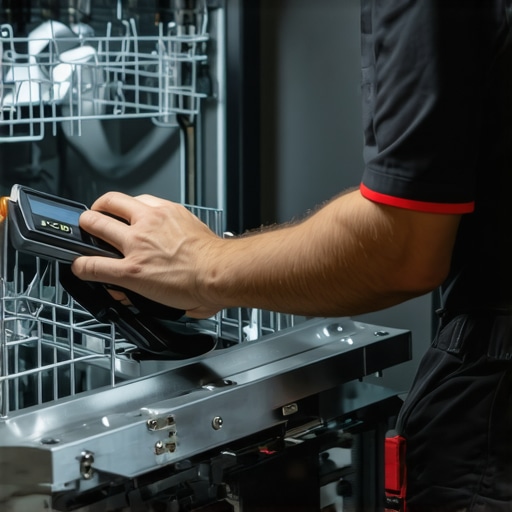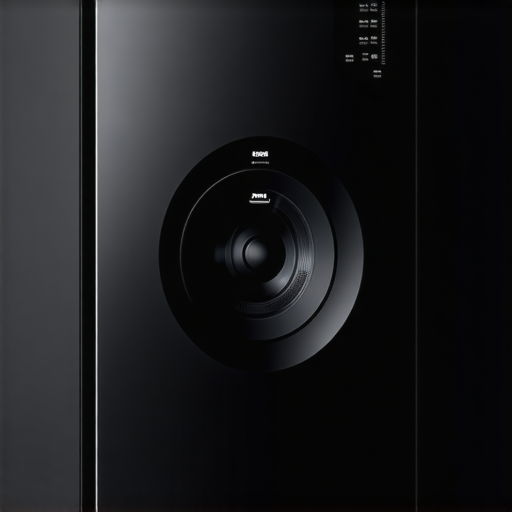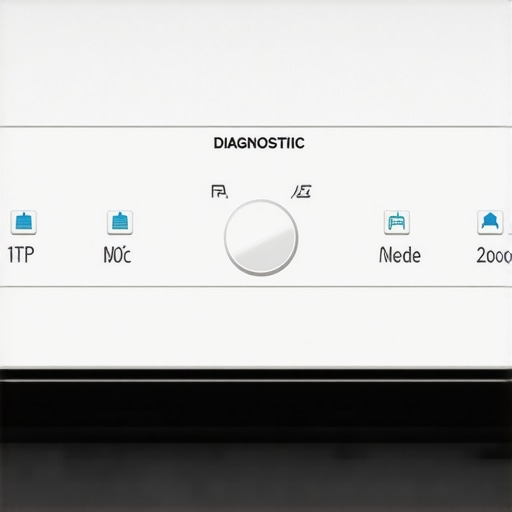My Journey with Dishwasher Warranties: A Personal Perspective
Living in a busy household, I rely heavily on my dishwasher to keep things running smoothly. A few months ago, I faced an unexpected issue when my dishwasher stopped draining properly. That’s when I realized how crucial understanding the warranty and parts replacement process is, especially for appliances I depend on daily. I decided to dive deep into the world of dishwasher warranties and maintenance, and I want to share my insights with you.
Why Knowing About Dishwasher Parts and Warranty Coverage Matters
When my dishwasher started acting up, I was initially overwhelmed. However, I discovered that many issues are related to specific parts that can be replaced easily if you know what to look for. Understanding the warranty coverage is essential because it can save you significant repair costs. For example, I learned that some parts, like the door latch or control panel, are covered under warranty if they malfunction within the coverage period. To deepen my knowledge, I visited authoritative sources like this comprehensive guide.
Easy Parts Replacement: My Go-To Tips
Replacing parts such as the spray arm or filter turned out to be simpler than I thought. I found that most parts are accessible with basic tools, and detailed instructions are often included in the user manual or available online. I also learned that knowing the key dishwasher parts, like the pump, motor, and control board, helps in diagnosing issues early. For example, if your dishwasher isn’t filling with water, it might be the inlet valve or float switch, which are usually straightforward to replace. For guidance on selecting the right parts, I recommend checking this resource.
Trusting the Warranty: When to Replace Parts and When to Call a Pro
During my troubleshooting, I wondered, “How do I know when a part needs replacing versus repair?” Well, I found that if a part shows visible damage or isn’t functioning even after cleaning, it’s time for a replacement. Sometimes, warranty coverage will even include professional repairs, which I highly recommend if you’re unsure about doing it yourself. Remember, always check your warranty details and keep your receipts and registration information handy. This helps maximize your warranty benefits, as explained in this helpful article.
What are the most common dishwasher parts that often need replacement?
From my experience and research, parts like the door latch, spray arms, filters, and inlet valves are among the most common components that wear out over time. Regular maintenance and inspection can prevent bigger issues later. If you’re interested in knowing more about the essential parts for troubleshooting and proper maintenance, check this detailed guide.
If you’re like me, navigating warranty policies and DIY repairs can feel daunting at first. But with a little knowledge and preparation, you can save money and extend the lifespan of your dishwasher. I invite you to share your experiences or ask questions in the comments below. And remember, effective maintenance is key to keeping your appliance running smoothly for years to come!
Understanding the Nuances of Dishwasher Parts: What Truly Matters?
As an appliance repair professional, I often encounter homeowners overwhelmed by the myriad of dishwasher parts and the intricacies of warranty policies. While basic knowledge is helpful, delving into the specifics—such as the role of each component—empowers you to make informed decisions that save money and extend your appliance’s lifespan. For example, understanding how the control board interacts with sensors can help diagnose electronic failures early. Additionally, awareness of the longevity and warranty coverage of parts like the door latch or pump can prevent costly repairs down the line. To deepen your understanding, explore this comprehensive guide.
How to Identify Critical Parts Before They Fail?
Proactively inspecting key components such as the spray arm, filters, and inlet valve can significantly reduce emergency repairs. Wear and tear are inevitable, but early signs—like unusual noises or poor cleaning—often indicate an impending failure. Regular maintenance, including cleaning filters and checking for cracks, can prolong the life of these parts. For instance, a clogged filter can cause drainage issues, which might seem minor but could lead to more severe damage if ignored. To learn about the essential parts to check during routine maintenance, visit this detailed resource.
What Are the Hidden Benefits of Proper Parts Selection in Warranty Claims?
Choosing the right parts initially can streamline warranty claims and repairs. When a component fails, having the correct part—matched specifically to your dishwasher’s model—ensures compatibility and reduces installation errors. Proper parts selection also influences warranty coverage, as some warranties are voided if incompatible parts are used. Additionally, understanding warranty nuances allows you to leverage coverage effectively, whether for parts replacement or professional repairs. For example, warranty policies often cover items like the motor or control panel if they malfunction under normal usage. For more insights on warranty coverage, check this authoritative guide.

Can Advanced Diagnostics Help Prevent Costly Repairs?
Modern dishwashers come equipped with diagnostic features that can identify issues before they escalate. An expert approach involves interpreting error codes and understanding the underlying causes—like a faulty float switch or a failing pump. Utilizing diagnostic tools or professional services can pinpoint problems early, saving time and money. For example, a recurring error related to the inlet valve may be resolved with a simple replacement, often covered under warranty if diagnosed correctly. Staying informed about these diagnostics can significantly improve your maintenance routine and warranty utilization. If you’re interested in learning more about troubleshooting techniques, I recommend exploring this expert resource.
Beyond Basic Repairs: The Intricacies of Dishwasher Parts and Their Hidden Roles
Over the years, my experience with dishwasher maintenance has evolved from simple fixes to a nuanced understanding of how each component interacts within the system. For instance, I’ve come to appreciate the critical role of the control board—not just as a mere electronic component, but as the brain orchestrating the entire cleaning process. When it fails, it’s often a sign that other underlying issues, such as faulty sensors or wiring problems, are at play. Recognizing these subtle signs has enabled me to troubleshoot more effectively, saving both time and money. If you’re interested in exploring these advanced insights, I recommend reviewing this comprehensive guide.
How Do You Prioritize Parts Replacement in Complex Situations?
In my journey, I’ve learned that not all parts are equal in terms of urgency or impact. For example, a worn-out door latch might be a minor inconvenience initially, but if it fails completely, it can prevent the dishwasher from sealing properly, leading to leaks and water damage. On the other hand, electronic components like the control panel may have a longer lifespan but can fail suddenly, requiring prompt replacement. The key is to develop a hierarchy based on symptoms and warranty coverage. I often ask myself, “Is this part critical to the operation, or is it a cosmetic issue?” This mindset helps me prioritize repairs and avoid unnecessary replacements. To deepen your understanding of these priorities, check out this detailed article.
What Are the Subtle Signs That Indicate a Part Is Nearing Failure?
One of the more fascinating aspects of advanced maintenance is recognizing early warning signs. For instance, I’ve noticed that even slight changes in noise levels or cycle times often point to impending issues with components like the pump or motor. Sometimes, a minor leak or an unusual smell can be traced back to gasket deterioration or mold buildup, which in turn affects internal parts. Paying close attention to these signs allows me to intervene proactively, often before the part fails completely. This approach not only prolongs the lifespan of the appliance but also makes warranty claims smoother, especially if the failure occurs within the coverage period. For further tips on diagnostics, I suggest exploring this expert resource.
How Can Proper Parts Selection Influence Long-Term Warranty Benefits?
From my perspective, choosing the right parts initially is a strategic decision that can significantly impact warranty claims. Inaccurate or incompatible parts can void warranties or lead to further damage. For example, selecting a high-quality, model-specific spray arm ensures optimal cleaning performance and reduces the likelihood of breakdowns. Moreover, understanding warranty nuances—like coverage limits on electronic versus mechanical parts—helps in planning repairs more effectively. I’ve found that maintaining detailed records of part purchases and service dates enhances my ability to leverage warranty benefits fully. If you’re curious about making smarter parts choices, I recommend reading this insightful guide.
Modern diagnostic features are game-changers in preventive maintenance. For example, many dishwashers now display error codes that, when interpreted correctly, can reveal underlying issues like a failing float switch or a defective inlet valve. I’ve found that investing in a basic diagnostic scanner or consulting professional services can reveal these hidden problems early, often covered under warranty. This proactive approach saves considerable repair costs and extends the appliance’s lifespan. If you’re eager to learn how to interpret these diagnostics, I recommend exploring this detailed resource.
Deciphering the Complex Interplay of Dishwasher Components and Warranty Protocols
Over years of hands-on experience, I’ve come to see how the intricacies of dishwasher parts—like the precise interaction between the control board, sensors, and water inlet—can significantly influence repair outcomes and warranty claims. For instance, understanding that a malfunctioning float switch may trigger false error codes led me to inspect related components before considering costly replacements. This nuanced knowledge not only streamlines troubleshooting but also fortifies your position when navigating warranty disputes. To deepen your grasp of these interactions, I recommend exploring this comprehensive guide.
Strategic Preemptive Diagnostics: Foreseeing Failures Before They Manifest
Advanced diagnostic features embedded in modern dishwashers—such as error code interpretations and sensor feedback—are invaluable tools. By proactively analyzing these signals, I often identify subtle signs of impending failure, like irregular cycle durations or faint leaks, which precede complete breakdowns. Investing in a diagnostic scanner or consulting expert services can reveal issues like a failing circulation pump or defective wiring, often covered under warranty if caught early. This proactive approach saves significant repair costs and extends appliance longevity. For detailed diagnostic techniques, I suggest reviewing this expert resource.
How Do I Prioritize Repairs When Multiple Components Fail Simultaneously?
In complex scenarios where several parts show signs of wear, I prioritize based on the component’s role in the dishwasher’s operation and warranty coverage. For example, a compromised door latch might seem minor but can cause leaks and prevent proper sealing, leading to water damage. Conversely, electronic issues like control panel failures may have a longer lifespan but require immediate attention if they halt the cycle entirely. Developing a hierarchy—considering symptoms, impact, and warranty terms—helps me make informed decisions. To refine your repair strategy, delve into this detailed article.
What Are the Subtle Indicators That a Critical Part Is Nearing End-of-Life?
Recognizing early warning signs is crucial. I’ve observed that minor changes in noise levels, slight odors, or inconsistent cycle timings often point to issues with components like the pump or gasket deterioration. For example, a faint grinding noise may signal a worn bearing, while a recurring leak hints at gasket failure. These subtle cues, if addressed promptly, can prevent complete breakdowns and maintain warranty validity. Paying close attention to such details enhances your ability to intervene proactively. For more diagnostic tips, I recommend exploring this helpful resource.
The Power of Precise Parts Selection to Maximize Warranty Advantages
Choosing the correct, model-specific parts initially can streamline warranty claims and improve repair success. Incompatible or low-quality replacements may void warranties or cause further damage, complicating future claims. For instance, selecting a high-quality, OEM-certified spray arm not only ensures optimal cleaning but also maintains warranty coverage. Additionally, meticulous record-keeping of parts procurement and service history strengthens your position during warranty discussions. To elevate your parts selection process, I encourage you to read this insightful guide.

Leveraging Diagnostic Technology for Preventive Maintenance and Cost Savings
The integration of diagnostic tools, whether built-in or via external scanners, revolutionizes maintenance routines. By interpreting error codes accurately—such as those indicating a faulty float switch or circulation pump—you can address issues early, often under warranty. This strategic diagnostic approach not only reduces repair expenses but also extends the dishwasher’s operational lifespan. Staying informed about these technological advancements allows homeowners to act swiftly and confidently. To explore effective diagnostic techniques, I recommend visiting this detailed resource.
Things I Wish I Knew Earlier (or You Might Find Surprising)
The Hidden Impact of Proper Part Selection
One thing I discovered through my experience is that choosing the right dishwasher parts isn’t just about fit—it can influence your warranty and how smoothly repairs go down the line. I once tried to replace a spray arm with an incompatible part, which voided my warranty and caused more issues. Now, I always double-check if I’m using OEM-certified parts, especially when it comes to critical components like the control board or inlet valve.
Early Signs Are More Telling Than You Think
I’ve learned to pay close attention to subtle changes in my dishwasher’s behavior—like unusual noises or slight leaks. These small signs often mean a part is nearing failure, and catching them early can save big money. Regular inspections of filters and gaskets have helped me prevent full-blown breakdowns and maintain warranty coverage.
Diagnostics Tools Are a Game-Changer
Modern dishwashers with diagnostic features have made troubleshooting so much easier. Interpreting error codes helped me identify issues like a faulty float switch before they turned into costly repairs. I now use basic diagnostic scanners to stay ahead of potential problems, often catching issues covered under warranty.
Understanding the Interplay of Components
I’ve come to realize that dishwasher parts don’t operate in isolation. For example, a malfunctioning control board might be linked to sensor issues or wiring problems. Recognizing these interactions has allowed me to troubleshoot more effectively, saving time and ensuring my warranty remains valid.
Prioritizing Repairs in Complex Situations
When multiple parts show signs of wear, I prioritize based on their role in the dishwasher’s operation. A worn door latch might cause leaks, but electronic failures like control panel issues can halt the entire cycle. Developing a repair hierarchy helps me avoid unnecessary replacements and focus on what’s most critical.
Resources I’ve Come to Trust Over Time
- Appliance Doctorz: Their comprehensive guides on dishwasher parts and warranties have been invaluable for understanding complex repair processes. I often refer friends here for reliable info.
- Consumer Reports: Their appliance ratings and maintenance tips are trustworthy and backed by thorough testing. I’ve found their advice practical for DIY repairs.
- Manufacturer Websites: Official sites like Whirlpool or Bosch provide detailed parts catalogs and warranty policies that are essential for accurate repairs and warranty claims.
Parting Thoughts from My Perspective
Looking back, understanding dishwasher parts and warranty coverage has transformed how I approach appliance maintenance. Being proactive—recognizing early signs of wear, choosing the right parts, and leveraging diagnostic tools—has saved me money and extended my dishwasher’s lifespan. If this resonates with you, I encourage you to stay curious, keep learning, and don’t hesitate to consult trusted resources like this guide. Sharing your experiences or questions can also help build a community of informed homeowners. Happy dishwashing!


